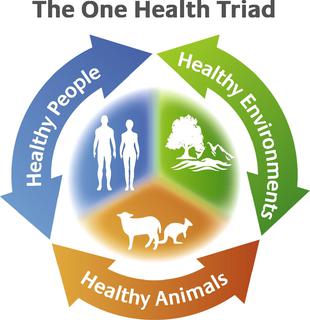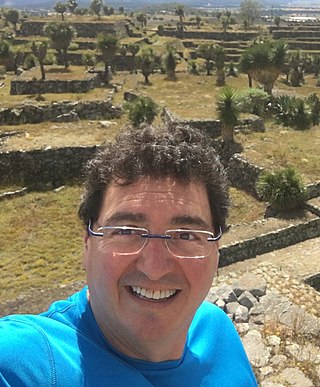
The World Organisation for Animal Health (WOAH), formerly the Office International des Epizooties (OIE), is an intergovernmental organisation founded in 1924, coordinating, supporting and promoting animal disease control.

A zoonosis or zoonotic disease is an infectious disease of humans caused by a pathogen that can jump from a non-human to a human and vice versa.
Biosecurity refers to measures aimed at preventing the introduction and/or spread of harmful organisms intentionally or unintentionally outside their native range and/or within new environments. In agriculture, these measures are aimed at protecting food crops and livestock from pests, invasive species, and other organisms not conducive to the welfare of the human population. The term includes biological threats to people, including those from pandemic diseases and bioterrorism. The definition has sometimes been broadened to embrace other concepts, and it is used for different purposes in different contexts.

Avian influenza, also known as avian flu or bird flu, is a disease caused by the influenza A virus (IAV) which primarily affects birds but can sometimes affect mammals including humans. Wild aquatic birds are the primary host of Influenza A virus (IAV), which is endemic in many bird populations.

Glanders is a contagious zoonotic infectious disease that occurs primarily in horses, mules, and donkeys. It can be contracted by other animals, such as dogs, cats, pigs, goats, and humans. It is caused by infection with the bacterium Burkholderia mallei.

Mycobacterium bovis is a slow-growing aerobic bacterium and the causative agent of tuberculosis in cattle. It is related to Mycobacterium tuberculosis, the bacterium which causes tuberculosis in humans. M. bovis can jump the species barrier and cause tuberculosis-like infection in humans and other mammals.
The National Association of State Public Health Veterinarians (NASPHV) develops and publishes uniform public health procedures involving zoonotic disease in the United States and its territories. These veterinarians work closely with emergency rooms, legislators, local officials, schools, health departments, and the general public to prevent disease exposure and control diseases that are transmitted to humans from animals and animal products.

Conservation medicine is an emerging, interdisciplinary field that studies the relationship between human and non-human animal health and environmental conditions. Specifically, conservation medicine is the study of how the health of humans, animals, and the environment are interconnected and affected by conservation issues. It is also known as planetary health, environmental medicine, medical geology, or ecological medicine.
EcoHealth Alliance is an US-based non-governmental organization with a stated mission of protecting people, animals, and the environment from emerging infectious diseases. The nonprofit focuses on research aimed at preventing pandemics and promoting conservation in hotspot regions worldwide.

In epidemiology, a disease vector is any living agent that carries and transmits an infectious pathogen such as a parasite or microbe, to another living organism. Agents regarded as vectors are mostly blood-sucking insects such as mosquitoes. The first major discovery of a disease vector came from Ronald Ross in 1897, who discovered the malaria pathogen when he dissected the stomach tissue of a mosquito.

The eradication of infectious diseases is the reduction of the prevalence of an infectious disease in the global host population to zero.

The Global Alliance for Rabies Control (GARC) is a non-profit organization that aims to eliminate deaths from canine rabies by 2030. Rabies is a neglected disease of poverty, which is almost 100% fatal, but can also be prevented with available vaccines. The Global Alliance for Rabies Control's work centers around the One Health Approach where vaccinating dogs stops the disease at its source and protects the whole community. Where the funding and political will exist, canine rabies has been eliminated. Inequality in access to preventive health care and proven control methods means that around 59,000 people, almost all in Africa and Asia, die every year.

The concept of One Health is the unity of multiple practices that work together locally, nationally, and globally to help achieve optimal health for people, animals, and the environment. When the people, animals, and environment are put together they make up the One Health Triad .The One Health Triad shows how the health of people, animals, and the environment is linked to one another. With One Health being a worldwide concept, it makes it easier to advance health care in the 21st century. When this concept is used, and applied properly, it can help protect people, animals, and the environment in the present and future generations.
The One Health Institute works at the interface of animals, people, plants, and the environment to solve complex problems that impact health and conservation around the world. The institute is part of the UC Davis School of Veterinary Medicine and is home to the Karen C. Drayer Wildlife Health Center and many other programs and projects. The executive director of the One Health Institute is Dr. Michael Ziccardi. The One Health approach recognizes that the health of domestic animals, wildlife, and people are inextricably linked to one another and the environment.
A Foreign animal disease (FAD) is an animal disease or pest, whether terrestrial or aquatic, not known to exist in the United States or its territories. When these diseases can significantly affect human health or animal production and when there is significant economic cost for disease control and eradication efforts, they are considered a threat to the United States. Another term gaining preference to be used is Transboundary Animal Disease (TAD), which is defined as those epidemic diseases which are highly contagious or transmissible and have the potential for very rapid spread, irrespective of national borders, causing serious socio-economic and possibly public health consequences. An Emerging Animal Disease "may be defined as any terrestrial animal, aquatic animal, or zoonotic disease not yet known or characterized, or any known or characterized terrestrial animal or aquatic animal disease in the United States or its territories that changes or mutates in pathogenicity, communicability, or zoonotic potential to become a threat to terrestrial animals, aquatic animals, or humans."
The World Organisation for Animal Health's Terrestrial Animal Health Code (TAHC) implements improvement standards of worldwide animal health and welfare and public health from a veterinary point of view. It includes standards international trade in terrestrial biological specimens and their merchandise. National veterinary authorities use it to provide for early detection of pathogens and to prevent the transfer of same by international trade in animals and animal merchandise, while skirting "unjustified sanitary barriers to trade".

Animal vaccination is the immunisation of a domestic, livestock or wild animal. The practice is connected to veterinary medicine. The first animal vaccine invented was for chicken cholera in 1879 by Louis Pasteur. The production of such vaccines encounter issues in relation to the economic difficulties of individuals, the government and companies. Regulation of animal vaccinations is less compared to the regulations of human vaccinations. Vaccines are categorised into conventional and next generation vaccines. Animal vaccines have been found to be the most cost effective and sustainable methods of controlling infectious veterinary diseases. In 2017, the veterinary vaccine industry was valued at US$7 billion and it is predicted to reach US$9 billion in 2024.

John Andrew Crump MB ChB, MD, DTM&H, FRACP, FRCPA, FRCP is a New Zealand-born infectious diseases physician, medical microbiologist, and epidemiologist. He is Professor of Medicine, Pathology, and Global Health at the University of Otago and an adjunct professor of medicine, Pathology, and Global Health at Duke University. He served as inaugural co-director of the Otago Global Health Institute, one of the university's research centres. His primary research interest is fever in the tropics, focusing on invasive bacterial diseases and bacterial zoonoses.

David Hayman is a New Zealand-based epizootic epidemiologist and disease ecologist whose general multi-disciplinary work focuses on the maintenance of infectious diseases within their hosts and the process of emergence and transmission to humans specifically related to bats. He has gathered data on the relationship between ecological degradation due to anthropogenic actions, and increased pathogen emergence in humans and animals. During COVID-19 he was involved as an expert in several international collaborations, some convened by the World Health Organization, and was a regular commentator in the New Zealand media about the country's response to the pandemic. He has had lead roles in research organisations at Massey University and Te Pūnaha Matatini and was the recipient of the 2017 Rutherford Discovery Fellowship Award. Since 2014 Hayman has been a professor at Massey University.

A. Alonso Aguirre is an American veterinarian, wildlife biologist, academic and researcher. He is Professor and Chair of the Department of Environmental Science and Policy, College of Science, and he also chairs the university Institutional Animal Care and Use Committee (IACUC) at George Mason University.















